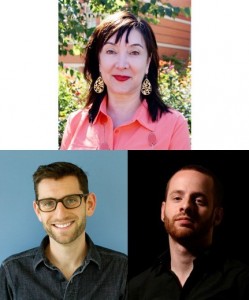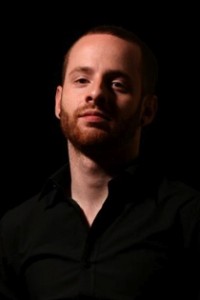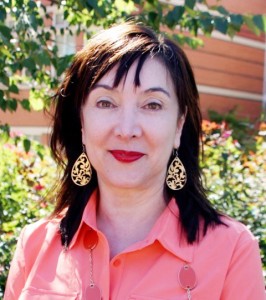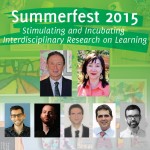Functional Near Infrared Spectroscopy (fNIRS) Neuroimaging Technology and Advances for Studies of the Science of Learning

HKU Sin Wai-Kin Distinguished Visiting Professor in the Humanities;
Full Professor, Department of Psychology, Gallaudet University, Washington, D.C. USA;
Co-PI & Science Director, NSF Science of Learning Center,
Visual Language and Visual Learning, VL2
Advanced doctoral students in the PhD in Educational Neuroscience program,
Gallaudet University, Washington, DC, and
2015 NSF Student Scholars in the NSF Science of Learning Center, VL2, and
Recipients of a NSF travel fellowship from the United States National Science Foundation
(Dr. Soo-Siang Lim, NSF Program Director and Chair of Coordinating Committee, Science of Learning Centers Program) and the NSF Office of International Science and Engineering
(Dr. Akaysha C. Tang, East Asia & Pacific Program Director)
Registration closed.
fNIRS Workshop Description
This fNIRS Workshop will focus on one of the world’s most advanced neuroimaging technologies for the study of human higher cognition, called functional Near Infrared Spectroscopy (fNIRS) — a neuroimaging technology that is especially optimal for the study of learning in babies, children, and adults across a wide variety of learning and social contexts (both in and out of the formal laboratory).
In Day 1, the Workshop will begin with a brief comparative review of contemporary neuroimaging technologies, the neurophysiological principles of measurement on which each neuroimaging technology operates, and the powerful relationship between the different types of neuroimaging systems and the range of questions that they can – and cannot – answer. Participants will learn about fNIRS brain imaging principles, contemporary investigations using fNIRS, experimental design (block vs event) and exciting new advances that involve fNIRS experimental designs that are yoked to other technologies (e.g., eye-tracking, thermal infrared imaging, etc.), fNIRS neuroimaging data analyses and techniques and their relation to the world’s other neuroimaging analysis packages, the ethical recruitment and treatment of participants in brain studies, confidential and ethical archiving of neuroimaging data, ethical use of brain measuring equipment, and the day will include a discussion of the ethical use of neuroimaging systems in society and education.
In Day 2, Workshop participants will enjoy a unique hands-on introduction to the components of a real Hitachi ETG-4000 fNIRS neuroimaging system, and they will observe a brief fNIRS adult study. The day will include detailed information on the preparation of a fNIRS neuroimaging experiment (including room preparation), how to conduct cranial measurement with research participants and techniques for probe placements (spanning children through adult research participants), methods for digital spatial and channel localization (and especially techniques for engaging infants, children, and adults during probe placements), the role of the Pilot and Co-Pilot during fNIRS experimentation, data acquisition (checks that all is working, data recording, data recording sheets and logbooks, and why they are vital), removal of probes from participants, data exporting and post-processing, and safety and care of ETC-4000 technology. Below please find an ‘at-a-glance’ summary of our two-day fNIRS Workshop.
Course structure
DAY 1, Morning (Part I)
- Principles of Brain Imaging
- Principles of fNIRS in Brain Imaging
- Contemporary Investigations Using fNIRS
- Experimental Design & Yoked Technologies
DAY 1, Afternoon (Part II)
- Experimental Design & Yoked Technologies
- fNIRS Data Analyses and Techniques
- Ethics of fNIRS/Brain Imaging Studies & Participant Recruitment
- Preview of a Complete fNIRS Adult Study Procedure
DAY 2, Morning (Part III)
- ETG-4000 Introduction and Components
- fNIRS Imaging Room Preparation
- Observe a fNIRS Adult Study
DAY 2, Afternoon (Part IV)
- Cranial Measurements and Probe Placement
- Digital Spatial and Channel Localization (Infants, Children, Adults)
- Pilot and Co-Pilot Roles
- Data Acquisition
- Probe Removal
- Data Exporting and Processing
- Safety and Care of ETG-4000 System
About the speakers
Professor/Dr. Laura-Ann Petitto
Co-Principal Investigator, and, Science Director of the
National Science Foundation, Science of Learning Center,
Visual Language and Visual Learning (VL2).
Scientific Director: Brain and Language Laboratory for Neuroimaging (BL2)
Full Professor: Department of Psychology, Gallaudet University
Affiliated Full Professor: Department of Psychology, Georgetown University
Washington, D.C. USA
Web page: http://www.gallaudet.edu/petitto.html
Professor Laura-Ann Petitto, a Cognitive Neuroscientist, is the Co-Principal Investigator, and Science Director, of the USA’s National Science Foundation’s Science of Learning Center, “Visual Language and Visual Learning, VL2” at Gallaudet University. She is also a Full Professor in the Department of Psychology at Gallaudet, an affiliated Full Professor in the Department of Psychology at Georgetown University, and the Scientific Director of her own Brain and Language Laboratory for Neuroimaging. Petitto is known for her role in the creation of the new discipline Educational Neuroscience, and she is one of the Co-Founders as well as Chair of the Steering Committee of the PhD in Educational Neuroscience program at Gallaudet University—the first program of its kind to be created in the United States. Petitto is renowned for her scientific discoveries concerning language and its neural representation in the human brain, how young children acquire language, the shared signed and spoken language processing sites and systems in the human brain, the Bilingual Brain (including sign and spoken bilinguals), and the Reading Brain (including how young signing children use a Visual Sign Phonology en route to deriving meaning from print). Petitto received her Masters Degree in 1981 and Doctoral Degree in 1984 from Harvard University’s Graduate School of Education, Department of Human Development and Psychology (“Psycholinguistics, Language and Cognition Track”). Petitto has won continuous Federal and/or Foundation funding for the past 30 years. She is the recipient of over 35 international prizes and awards for her scientific achievements and discoveries, including the 1998 Guggenheim Award for her “unusually distinguished achievements in the past and exceptional promise for future accomplishment in the Neurosciences.” In 2009, Petitto was appointed a Fellow of the American Association for the Advancement of Science, and a Fellow of the Association for Psychological Science (APS). See http://www.gallaudet.edu/petitto.html
 Adam Stone is a Ph.D. student in the PhD in Educational Neuroscience (PEN) program at Gallaudet University. He is also a NSF Science of Learning Center, Visual Language and Visual Learning (VL2) student scholar and a research assistant in Professor Laura-Ann Petitto’s Brain and Language Laboratory for Neuroimaging (BL2), who is also Stone’s Primary Advisor. Adam has a MA in ASL/English Bilingual Education from the University of California, San Diego and is a former elementary teacher and children’s book author. His primary area of study involves neuroscience investigations of literacy development and bilingual reading in deaf children, and educational technology applications that promote sign language acquisition and literacy in deaf children. Presently, he is pursuing scientific hypotheses about how the human brain builds visual sign phonological representations and how this can afford higher cognitive advantages on young deaf visual learners’ acquisition of English and reading success.
Adam Stone is a Ph.D. student in the PhD in Educational Neuroscience (PEN) program at Gallaudet University. He is also a NSF Science of Learning Center, Visual Language and Visual Learning (VL2) student scholar and a research assistant in Professor Laura-Ann Petitto’s Brain and Language Laboratory for Neuroimaging (BL2), who is also Stone’s Primary Advisor. Adam has a MA in ASL/English Bilingual Education from the University of California, San Diego and is a former elementary teacher and children’s book author. His primary area of study involves neuroscience investigations of literacy development and bilingual reading in deaf children, and educational technology applications that promote sign language acquisition and literacy in deaf children. Presently, he is pursuing scientific hypotheses about how the human brain builds visual sign phonological representations and how this can afford higher cognitive advantages on young deaf visual learners’ acquisition of English and reading success.
 Geo Kartheiser is a Ph.D. student in the PhD in Educational Neuroscience (PEN) program at Gallaudet University. He is also a NSF Science of Learning Center, Visual Language and Visual Learning (VL2) student scholar and a research assistant in Professor Laura-Ann Petitto’s Brain and Language Laboratory for Neuroimaging (BL2), who is also Kartheiser’s Primary Advisor. Kartheiser currently holds the prestigious Ruth L. Kirschstein National Research Service Award Individual Predoctoral Fellowship (F31) from the United States National Institutes of Health. His primary area of interest involves studies of visual attention, brain plasticity, and signed-language assessment tools. Presently, he investigates the limits and boundaries of neural plasticity by examining the brain changes and concomitant cognitive impact that occur when adults learn a new language well after the sensitive periods for human language acquisition have stabilized. Specifically, he is studying how learning a signed language past the sensitive period impacts the neural networks that support language, learning, higher cognition and the processing of visual spatial information. He is further interested in how scientists can improve their dissemination of knowledge in most effective ways with the public.
Geo Kartheiser is a Ph.D. student in the PhD in Educational Neuroscience (PEN) program at Gallaudet University. He is also a NSF Science of Learning Center, Visual Language and Visual Learning (VL2) student scholar and a research assistant in Professor Laura-Ann Petitto’s Brain and Language Laboratory for Neuroimaging (BL2), who is also Kartheiser’s Primary Advisor. Kartheiser currently holds the prestigious Ruth L. Kirschstein National Research Service Award Individual Predoctoral Fellowship (F31) from the United States National Institutes of Health. His primary area of interest involves studies of visual attention, brain plasticity, and signed-language assessment tools. Presently, he investigates the limits and boundaries of neural plasticity by examining the brain changes and concomitant cognitive impact that occur when adults learn a new language well after the sensitive periods for human language acquisition have stabilized. Specifically, he is studying how learning a signed language past the sensitive period impacts the neural networks that support language, learning, higher cognition and the processing of visual spatial information. He is further interested in how scientists can improve their dissemination of knowledge in most effective ways with the public.




